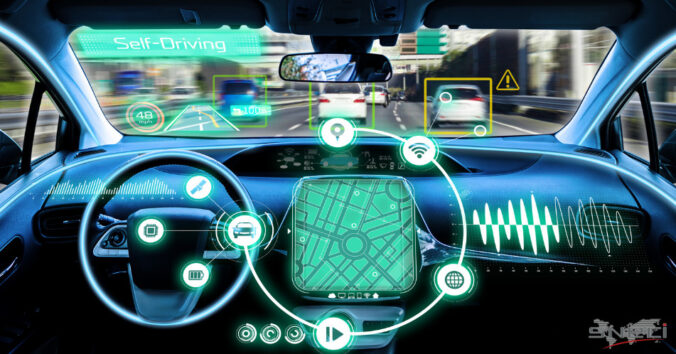ADAS systems: definition, advantages and training

Every year, several hundred people are killed due to road accidents. The human factor (drowsiness, driving under the influence, telephone use…) is responsible for more than 90% of road accidents. This is why car manufacturers are trying to develop technologies that make road trips safer, smoother and more comfortable. This is precisely the interest of the ADAS “Advanced Driver Assistance Systems”.
Indeed, the main goal of ADAS is to reduce the risks related to the human factor while driving. It includes safety systems and advanced technologies to accompany and assist the driver during his journey.
The Insurance Institute for Highway Safety (IIHS) predicts that currently available ADAS technologies could prevent or mitigate the effects of 1.8 million crashes each year, thereby protecting up to 10,000 lives per year, worldwide.
Let’s discover the different ADAS tools that vehicles can be equipped with today.
The different ADAS technologies available today
ADAS, depending on the technologies they include, can detect the presence of potential hazards (not visible from a distance or at night), analyze the environment around the driver and send key information to the user (this data will be transmitted to the driver to take the necessary measures to avoid an accident).
It is also important to know that ADAS include both active and passive systems.
- Active systems : the vehicle is able to take action itself to prevent the worst from happening.
- Passive systems : crucial information is transmitted to the driver to enable him to make the right decisions on the road.
There are two main families of ADAS, those intended for the safety of road users and those intended for road comfort
ADAS systems specifically designed for the safety/protection of road users.
- ABS (anti-lock braking system): it prevents the wheels from locking up during sudden braking.
- AFU (emergency brake assist): this is a braking assistance system that allows the driver to brake in an emergency with maximum power. Some car manufacturers include in their vehicles, the automatic activation of the hazard lights in addition to the EBA, to warn other road users of the potential danger.
- ESP (Electronic Stability Program): it allows the correction of trajectory deviations by acting on the braking system (especially in curves).
- FCW (Forward Collision Warning): thanks to a sensor/radar located at the front of the vehicle, it “monitors” the road and reduces the risk of collision between two vehicles. It alerts the driver with a visual and audible signal when there is a high risk of collision.
- LCA (Lane Change Assistant): assists the driver in changing lanes safely thanks to the radar that detects blind spots. If a vehicle gets too close to the other driver, the driver receives a warning light to encourage him or her to stop the lane change.
- ISA (Intelligent Speed Assist): It reduces engine power when it detects that the speed limit is overpassed. It is equipped with a camera that makes it capable of recognizing speed limit signs from a distance.
- DAW (Driver Drowsiness and Loss of Attention Warning System): this is a particularly innovative tool. It detects signs of tiredness in the driver thanks to a device that films his face and is able to detect signs of drowsiness. In addition, in the event of repetitive sudden movements, it will alert the driver in order to encourage him to take a break.
- DTS (dynamic steering torque): it includes a system that allows it to keep the vehicle stable when the road lacks grip. This makes it easier to handle the steering wheel, giving you better control over the vehicle.
- NVS (night vision system): its main objective is to help the driver drive at night by increasing visibility on the road. It provides a vision that goes beyond the range of the vehicle’s headlights. The NVS includes infrared sensors that also indicate on the navigation screen what road to follow.
The other ADAS are focused on comfort and driving flexibility.
- Start & Stop : this system mainly allows to save money by limiting the fuel consumption of the vehicle. It detects when the vehicle is stopped and stops the engine when the situation allows it (for example: when the user stops at a red light and puts the car in neutral). The start & stop system allows the engine to start again as soon as the driver presses the clutch again…
- Hill start assist : as its name suggests, this is a technology that helps the driver to start the car safely on a hill. It prevents the car from stalling or rolling backwards during this operation.
- Backup camera: It helps to better guide the vehicle’s steps (especially when reversing) thanks to a camera with a 360° vision, which transmits to the driver (on the navigation screen), the view of everything that passes around the vehicle.
- Parking space detection system: this tool allows the driver to find a free parking space more easily by detecting unoccupied spaces. In addition, it has sensors that indicate whether the available space is large enough for the vehicle that wants to park there.
All of the above-mentioned tools allow technology to be used for road safety and to make driving more comfortable for users. Moreover, SNECI also offers a training course dedicated to the ADAS of autonomous vehicles in partnership with SIA & FIEV.
Discover our SNECI training: Automation of Vehicle Functions, from ADAS to autonomous vehicles.
European car manufacturers are constantly innovating and the competition is fierce. ADAS systems are one of the R&D axes of car manufacturers associated with green mobility with electric vehicles, hybrids… Indeed, it is estimated that autonomous vehicles will take more and more place in the automotive sector in the years to come.
SNECI, in partnership with the SIA and the FIEV, offers a training course for anyone in the automotive industry involved in the design, manufacture or repair of automotive systems and components. It is also suitable for people wishing to understand and support the transition to the autonomous vehicle.
Designed in collaboration with the SIA (Société des Ingénieurs de l’Automobile – Society of Automotive Engineers) and the FIEV, it meets several objectives:
- Identify the technical, economic and societal issues related to the arrival of autonomous vehicles.
- Identify the main services provided by ADAS.
- To be able to understand and describe the main technological components used to create ADAS as well as their implementation constraints in the vehicle
Delivered by an SIA trainer, this training will allow you to better understand the progressive automation of the main functions of the vehicle and to familiarize yourself with the technologies of the autonomous vehicle by the ADAS systems.
All of our SNECI training courses are available as distance learning and/or face-to-face courses, at your convenience. SNECI offers 33 customized training and coaching courses, available in 14 languages around the world. With a 97% satisfaction rate, our training courses are QUALIOPI (training organization n° 11 92 18 377 92) and DATADOCK certified.
Do not hesite to have a look at all our training courses or to contact us if you want additional informations.






